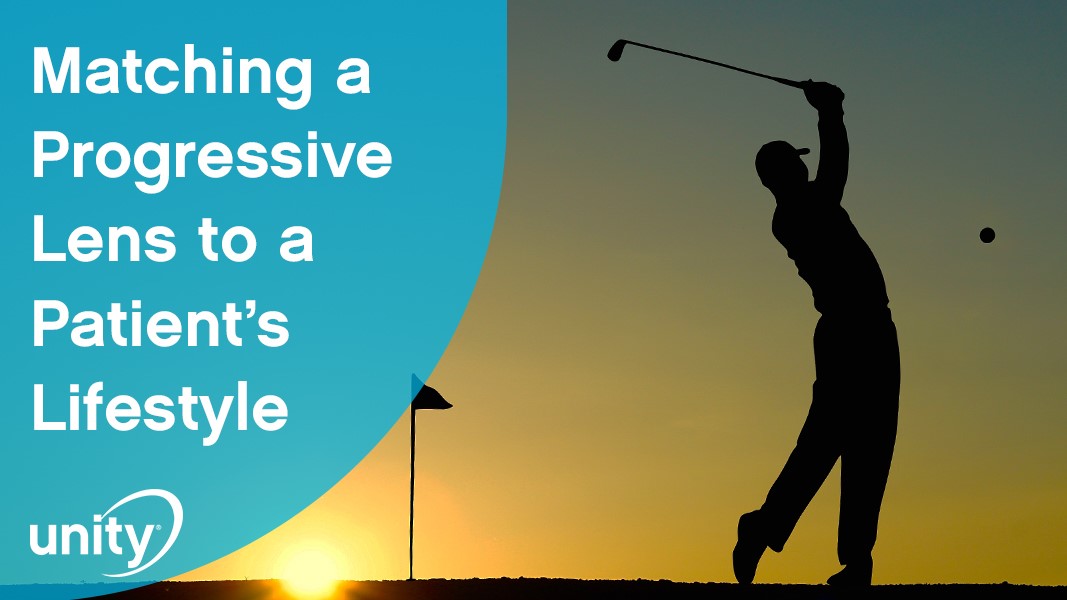Dispensing Progressives (Part 1 of 5): Matching a Progressive Lens to a Patient's Lifestyle5/18/2020
Much like owning a car, corrective eyewear is something a patient will need and use every day. But nothing can be more frustrating for a patient than being recommended something that falls short of solving their specific vision needs.
Think about what it’s like to pick out a new car.
You make your way to a nearby lot. Shortly after arriving, you’re approached by a slick salesperson with a lot to say. They know nothing about you and can’t wait to push you into the hot new sports car. “Believe me; this car has ‘you’ written all over it,” he says enthusiastically. Based on this situation, you probably wouldn’t have the best car-buying experience. Now let’s imagine the same scenario. Only this time, the salesperson knows that you love the backcountry, prefer a manual transmission, and can usually be found traveling with your camper in tow. In which case a pick-up truck with 4-wheel drive and a stick shift is a better fit for your life than an overpriced convertible. The difference between these two approaches means that the salesperson has taken the time to get to know you and is putting your interests and needs ahead of their commission. This leads to a better overall experience for you. A vehicle has yet to be created that’s a perfect fit for every driver. The same goes for eyewear. Asking a presbyopic patient about their habits, preferences, and overall daily life gives you invaluable insight into what lenses and enhancements to recommend. For this reason, gaining a thorough understanding of their lifestyle is crucial for dispensing success. Lifestyle Questionnaires: The Key to a Remarkable Experience
It’s essential to know as much as possible about a patient’s daily activities so you can recommend the right lens and enhancement. Asking the right questions matters and your ability to transform a person’s responses into a great visual experience has a remarkable impact on their experience with you and the practice.
This is why the patient questionnaire is so common across the industry. Every practice likely has a patient lifestyle questionnaire of some kind. As powerful as this tool can be, many ECPs may not be using them to their full potential. Here’s a look at three ways your practice can unlock the benefits of a well-crafted lifestyle questionnaire. 1. Add Specific Lifestyle Questions for Progressive Patients
Putting a patient into progressive lenses obviously comes down to their prescription, but that doesn’t mean a lifestyle questionnaire isn’t helpful.
For instance, understanding that a patient prioritizes aesthetics (as many do), can be hugely beneficial in converting them over from a lined multifocal. Or knowing they are constantly shifting from indoors to outdoors can help you steer them in the direction of a progressive with a light-reactive lens enhancement. Remember, most patients don’t think in terms of lenses and enhancements. They simply look at the total package as one pair of glasses. With this in mind, you’ll want to review your current questionnaire and ask yourself:
Here are several questions that are musts for progressive wearers.
2. Utilize the Questionnaire at Every Point in the Patient Journey
The normal procedure for a patient’s annual eye exam might look something like this:
But here’s a consideration that many practices overlook: the questionnaire is a critical component at every stage of the visit. Doing this can create a personalized experience at every point in the patient journey. It can also make the patient feel like the practice has taken the time to get to know them. Integrating the questionnaire throughout the practice allows each person involved in the patient’s visit to have an in-depth understanding of their wants, needs, and current issues. The better you understand the patient, the easier it is to customize their eyewear and personalize their experience. A well-crafted questionnaire should also benefit you and the entire practice by keeping things streamlined and efficient throughout a patient’s visit. Ideally, the patient should fill out the questionnaire before their appointment. Knowing the pertinent information ahead of time means you’re not spending time asking those questions during the visit. 3. Use Questionnaire Responses to Identify Needs for Custom Enhancements and Multiple Pair Recommendations
By optimizing your questionnaire, you’ll be able to round out a comprehensive and personalized optical package for your patients. It’ll also open doorways to smart recommendations for solution-oriented enhancements and additional pairs.
By connecting the benefit of an enhancement and/or additional pair to a patient’s questionnaire responses, you make the value tangible. That allows the patient to visualize how their vision and life will be better with your suggestion. Here’s an example of a personalized approach versus a generic approach: “We always recommend adding a blue-light-reducing coating to our patients because we’re all on devices all the time and the blue light they give off is dangerous.” Versus: “Mrs. Jones, I recall you look at a computer screen for about six to eight hours a day and you complained about daily neck pain, headaches and irritated eyes. These are can be symptoms of digital eye strain due to blue light exposure. I’d highly recommend a computer lens with a blue-light-reducing anti-reflective coating. The computer lens is specifically designed to provide the best vision where you typically view your computer screen. So, you won’t have to keep tilting your head and craning your neck to find that visual sweet spot. And the coating will give you all the benefits of a normal AR while also reducing the amount of blue light your eyes are taking in from your monitor or phone throughout the day.” Which approach would you prefer as a patient? Dispensing Progressives & Patient Lifestyles
Insight into a patient’s life is almost as important as their prescription when you want to make the best recommendations for their new eyewear.
A lifestyle questionnaire is a powerful tool. When used properly, a refined questionnaire has the potential to:
Once a patient has been identified as a good candidate to try progressive lenses, the next step is to discuss how these lens designs can improve their overall vision and daily lives. Keep a lookout for part two in this progressive lens dispensing series where you’ll learn how to successfully communicate the benefits of progressives.
0 Comments
Your comment will be posted after it is approved.
Leave a Reply. |
Don't Miss Out!
Subscribe to the In_Sight Newsletter to get the latest blog posts delivered directly to your inbox. Popular Posts
5 Digital Eye Strain Hacks to Enhance Patient and Practice Experience Changing Your Preferred Progressive Lens: A Blueprint for A Successful Switch (Part I) How Unity Via Helped this New Jersey Practice Overcome Change Anxiety Categories
All
|
©2024 Plexus Optix, Inc. All rights reserved.
Unity, SunSync, and TechShield are registered trademarks of Plexus Optix, Inc. All other brands or marks are the property of their respective owners.
Use of these marks, names, logos, and/or brands does not imply endorsement.
Unity, SunSync, and TechShield are registered trademarks of Plexus Optix, Inc. All other brands or marks are the property of their respective owners.
Use of these marks, names, logos, and/or brands does not imply endorsement.
Website by Eyefinity




 RSS Feed
RSS Feed
